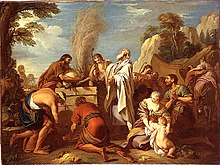Charles-Joseph Natoire
Charles-Joseph Natoire (3 March 1700 – 23 August 1777) was a French painter in the Rococo manner, a pupil of François Lemoyne and director of the French Academy in Rome, 1751–1775. Considered during his lifetime the equal of François Boucher, he played a prominent role in the artistic life of France.
He is remembered above all for the series of the History of Psyche for
First Roman stay (1723–1729)
He was born in Nîmes. His sister, Jeanne, was a pastellist.[1]
Natoire's father Florent Natoire, a sculptor, gave him his fundamental training in drawing, then sent him to Paris in 1717 to complete his training, first in the atelier of Louis Galloche (1670–1761), peintre du Roi and professor at the Académie royale de peinture et de sculpture, and then in the atelier of François Lemoyne, whose training shaped Natoire's style.[2] Later, as a history painter, Natoire would instruct students at the Royal Academy.[3]

In 1721 he was awarded the
In Paris (1730–1751)
Natoire returned to Paris via Venice in the early part of 1729. He was received into the Académie royale de peinture et de sculpture on 30 September 1730.
His reputation was quickly established, and he received major commissions notably from French Queen Marie Leszczyńska to paint several of her children. From 1731 to 1740 he provided several suites of canvasses for Philibert Orry, contrôleur général des finances, who was to succeed the duc d'Antin as general director of the Bâtiments du Roi in 1736. For Orry's Château de La Chapelle-Godefroy at Saint-Aubin, Aube Natoire provided a series of nine canvasses of Histories of the Gods, six more of the History of Clovis, six of a History of Telemachus and four Seasons. During the same period, in 1732 he provided three overdoors on Old Testament subjects for the duc d'Antin in Paris.

In June 1734, Natoire submitted to an Exposition de la Jeunesse in place Dauphine a Galatea. In the same year his first royal commission arrived, for the Chambre de la Reine at
In 1735, Natoire carried out the first of his tapestry cartoons for the series Histoire de Don Quichotte woven at the Manufacture de Beauvais, the first set for the
In 1747, he painted the portrait of
Second Roman stay (1751–1777)
In 1751, Natoire was appointed director of the French Academy in Rome, a prestigious position, but one that was to set a seal on his active career. Far from court, Natoire witnessed his rivals

He was ennobled in April 1753 and received the
Natoire's late work, in the two decades that remained to him was largely confined to numerous drawings of the Campagna for his own pleasure, and few canvasses. He became more religious.
In 1767, the architect Adrien Mouton, who had been expelled from the Academy, brought a suit that he won in 1770: Natoire was fined 20,000 livres and court costs with interest, accused of administrative errors. The new general director of the Bâtiments, the
He withdrew to Castel Gandolfo, where he died.
Gallery of selected work
-
Sibylle
-
Portrait of French bishop and theologian Jean-Joseph Languet de Gergy.
-
Psyche and Proserpina.
-
Young women with roses.
-
The Rebuke of Adam and Eve (1740)
-
The Triumph of Bacchus
References
- ^ Profile of Jeanne Natoire in the Dictionary of Pastellists Before 1800.
- ^ "Charles Joseph Natoire:The Rebuke of Adam and Eve", The Metropolitan Museum of Art
- ^ "Charles-Joseph Natoire", The Frick Collection
- ^ a b "Charles-Joseph Natoire (1700-1777)", The Royal Collection Trust
- ^ a b c "Charles-Joseph Natoire", Getty Museum Collection
- ISBN 978-1409400639.
- This article depends in large part on a translation from French Wikipedia, where a list of Natoire's paintings may be found.






